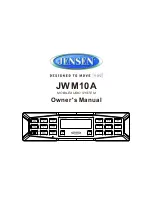Setting up VPT100 System
1. Interpreter Location: Position the interpreter with the VPT100 system in rear of room
(recommended).
2. Install the Antenna of T27 transmitter . Gently thread the ANT 021 rubber duckie antenna
onto the stud in the hole on the top of the transmitter.
3. Connect the Transmitter Power: Locate the TFP 036 power supply cord equipped with the
5-pin DIN connector, then plug the connector into the “Power In” jack located in the back of
the T27. Plug the power supply into the AC outlet.
4. Select the Frequency: The T27 has 8 major channels in the 72-76 MHz band.
To change the frequency on the T27, press and release the down or up. Each language will
use their own transmitter and transmit on a unique channel. Use channel guide to select
transmission channel for each language.
5. Connect the microphone to the “Mic Input” (pink plug)
Adjusting Audio:
Audio Level LED // Never On = Audio is TOO LOW.
// Blinks occasionally = Audio is OPTIMAL. // Always on = Audio is TOO HIGH.
6. Confirm transmission by listening to FM Receiver.
Monitoring Unit
7. Connect the PM50 Monitoring Unit Power .
Locate PS21 power cord and plug to side of Monitoring Unit.
8. Connect the headphone to the “Phones” (green plug)
9. Connect audio feed for “Mic In” on Monitoring Unit using
XLR cable (three prong cable)
10. Confirm feed with headset. You should be able to hear all
audio from sound system on interpreter headset.
Your system is ready to be used.
The interpreter will be able to adequately listen to the presentation/s
in their headset and in turn will be able to transmit their voice
wirelessly into the room. Your attendees will be able to hear all
interpretation on their receivers once they select the channel and
language they choose to listen to.
Each person will adjust their volume independently on their receiver.
Receiver Management Suggestions
Different types of facilities will use different approaches for receiver management
and earphone sanitation. Below are some options that customers have used
successfully.
• Regular users purchase their own receiver and take care of their own batteries
and earphone.
• Some facilities label the receiver and earphone with the names of regular users
so each person uses the same receiver and earphone.
• The receivers can be stored in a multiple compartment storage case with a
credit card or driver’s license left as collateral for the receiver.
• Regular users purchase their own earphone or headphone and bring them to
use with receivers at the facility.
Operating the Receiver
Turn the receiver on by rotating the volume control knob. The ON indicator should
illuminate RED. Choose from 8 standard channels. Turn the channel selector knob to
the desired channel.
IMPORTANT: Make sure the receiver channel matches the transmitter frequency!
Adjust the volume to a comfortable listening level. To turn the receiver off, rotate
the volume control knob to the left until it clicks off. The ON indicator should not be
lit. To prolong the battery life of the unit, turn the receiver off when it is not in use.
Troubleshooting Guide
Transmitter frequency display (LED) not lit.
• Make sure the wall transformer is plugged into the transmitter.
• Make sure the electrical outlet is on.
No sound through receivers.
• If some of the receivers work, but others don’t, check for bad batteries or earphones
on the receivers that aren’t working.
• Check to see that the receiver frequency matches the transmitter frequency.
• If none of the receivers work, check to see if the power is connected to the transmit-
ter and the frequency display on the front of the transmitter is illuminated.
• Turn the screwdriver-adjust audio input level control on the front panel of the T27
transmitter clockwise to increase the audio level. Make sure that the audio light is
flashing occasionally but not continuously.
• Make sure the antenna is installed and connected properly.
Insufficient range, good reception near transmitter, poor at a distance
• Check to see if the antenna was installed correctly. If not, correct or replace the
antenna. The signal should be clearly audible at least 100 ft with line of site to
transmitter antenna.
• Check to make sure no other transmitters (or other devices) are transmitting on the
same frequency (channel).
Sound through receivers is loud, but distorted. Noise (room noise or electronic
noise) seems to grow after talking stops. Audio Indicator Lights up continuously.
• Turn the screwdriver-adjust audio level control on the front of the T27 transmitter
counter-clockwise to decrease the audio level. The audio indicator light should flash
occasionally, but not be lit continuously.
Sound through the receivers is weak and noisy.
• Turn the screwdriver-adjust audio level control located on the T27 front panel
clockwise to increase the input signal strength. The audio indicator light should
flash occasionally.
• Increase the input signal level from the sound system.
Buzzing or humming noise in sound system.
• There is nothing wrong with the T27 Transmitter. One or more pieces of equipment
in the sound system are being disturbed by RF (Radio Frequency) signals produced
by the T27. The most likely suspects are other equipment primarily through the
power cord, speaker wires, or unshielded inputs, all of which can act as antennas
• Move the Transmitter away from the other sound equipment.
• The most likely suspects are other equipment primarily through the power cord,
speaker wires, or unshielded inputs, all of which can act as antennas. Try the
following steps:
1. Move the Transmitter away from the other sound equipment.
2. Make sensitive equipment more immune to RFI/EMI.
If you experience difficulty with your system,
call Toll-Free for customer assistance:
1.800.792.5020
or send text message to:
VPT100 Setup Guide
1
2
3
Freq. (MHz)
R35-8 CH
72.1
1
72.3
2
72.6
3
72.8
4
74.7
5
75.4
6
75.7
7
75.9
8
Channel Guide
Summary of Contents for VPT100
Page 2: ......


















